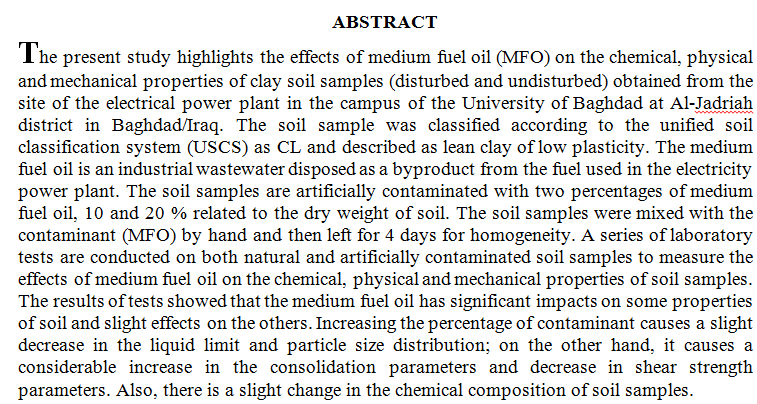
Al-Si alloys which are widely used in engineering applications due to their outstanding properties can be modified for more enhancements in their properties. Current work investigated the ability of these alloys to be modified by casting them through the addition of nanoparticles. So, Multi-wall carbon nanotubes (CNT) and titanium carbide ceramic particles (TIC) with size of (20 nm) were added with different amounts started from (0.5 up to 3%) weight to cast alloy A356 that was considered to be the base metal matrix, then stirred with different speeds of (270, 800, 1500, 2150) rpm at 520 °C for one minute. The results showed change in microstructure’ shape of the casted alloys from the dendritic to spherical gra
... Show More (9)
(9)
 (10)
(10)
Oil well drilling fluid rheology, lubricity, swelling, and fluid loss control are all critical factors to take into account before beginning the hole's construction. Drilling fluids can be made smoother, more cost-effective, and more efficient by investigating and evaluating the effects of various nanoparticles including aluminum oxide (Al2O3) and iron oxide (Fe2O3) on their performance. A drilling fluid's performance can be assessed by comparing its baseline characteristics to those of nanoparticle (NPs) enhanced fluids. It was found that the drilling mud contained NPs in concentrations of 0,0.25, 0. 5, 0.75 and 1 g. According to the results, when drilling fluid was used without NPs, the coeff
... Show More (2)
(2)
The research amid to measure the extent of the Suggested procedures of the internal control in accordance with the updated COSO framework in improving the procedures for internal control work in Iraqi oil companies. As the research problem was represented in suggesting procedures for internal control according to the updated COSO framework and finding out the relationship of correlation and influence between the suggested procedures and the internal control procedures that are done in the Iraqi oil companies. The research followed the quantitative approach to handling and analysing data by designing a Questionnaire to represent the research tool for collecting data. The study population was represented in the Iraqi oil companies,
... Show MoreA new nano-sized NiMo/TiO2-γ-Al2O3 was prepared as a Hydrodesulphurization catalyst for Iraqi gas oil with sulfur content of 8980 ppm, supplied from Al-Dura Refinery. Sol-gel method was used to prepare TiO2- γ-Al2O3 nano catalyst support with 64% TiO2, 32% Al2O3, Ni-Mo/TiO-γ-Al2O3 catalyst was prepared under vacuum impregnation conditions to loading metals with percentage 3.8 wt.% and 14 wt.% for nickel and molybdenum respectively while the percentage for alumina, and titanium became 21.7, and 58.61 respectively. The synthesized TiO2- γ-Al2O3 nanocomposites and Ni-Mo /TiO2
... Show More (7)
(7)
 (5)
(5)
A modified water injection technique has organized by this study to improve oil recovery of the Mishrif reservoirs using polymerized alkaline surfactant water (PAS-Water) injection. It is planned to modify the existing water injection technology, first to control and balance the hazardous troublemaker reservoir facies of fifty-micron pore sizes with over 500 millidarcies permeability, along with the non-troublemaker types of less than twenty micron pore sizes with 45 to 100 millidarcies permeability. Second to control Mishrif reservoirs rock-wettability. Special core analysis under reservoir conditions of 2250 psi and 90 °C has carried out on tens of standard core plugs with heterogeneous buildup, using the proposed renewal water f
... Show More (3)
(3)
 (6)
(6)
 (7)
(7)
natural and non-natural disasters, is an environmental challenges the society and the economy as well as a direct and indirect economic affect, and the units are part of the system overlapping among themselves and thus affected by external indicators, directly or indirectly, these direct effects appear in the destruction or damage inflicted by disasters in property , infrastructure , superstructure , accounting information systems and indirectly in the outcome of future business, comes research problem through access to accounting treatments issued by the Federal Office of financial supervision to address the damage caused by the disasters and prepare the missing financial accounts it turns out us that there is negligence of a nu
... Show More (2)
(2)
Background: Polymethyl methacrylate (PMMA) is the most commonly used material in denture fabrication. The material is far from ideal in fulfilling the mechanical requirements, like low impact and transverse strength, poor thermal conductivity. The purpose of this study was to evaluate the effect of addition a composite of surface treated Nano Aluminum oxide (Al2O3) filler and plasma treated polypropylene fiber (PP) on some properties of denture base material. Materials and methods: One hundred fifty prepared specimens were divided into 5 groups according to the tests, each group consisted of 30 specimens and these were subdivided into 3 groups (unreinforced heat cured acrylic resin as control group),reinforced acrylic resin with( 0.5%wt Nan
... Show More